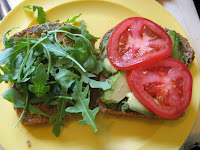 I don't particularly love to exercise. I love how I feel afterwards (both physically and mentally) but transitioning from whatever fun thing I'm doing to something physically challenging doesn't come naturally to me. Also, I accept that a little discomfort now will mean tremendous benefits in the future -- I want to be a healthy, active grandma one day, and I won't accomplish that feat by sitting around and making excuses about why I don't exercise.
I don't particularly love to exercise. I love how I feel afterwards (both physically and mentally) but transitioning from whatever fun thing I'm doing to something physically challenging doesn't come naturally to me. Also, I accept that a little discomfort now will mean tremendous benefits in the future -- I want to be a healthy, active grandma one day, and I won't accomplish that feat by sitting around and making excuses about why I don't exercise.Probably the biggest barrier to regular exercise is TIME. For years I carved out an hour block whenever I could for exercise. But running a business, being a mom, and running a household leave little time for such continuous stretches. However, I (and you, and you, and you) DO have 5 minutes here, 10 minutes there, throughout the day. What's the best use of that time? Not a jog through the woods, because once you get your running shoes and ipod ready, your 10 minutes are up. No, the best thing is to have something set up where you spend the bulk of your day.
For me, the bulk of the workday is spent in my office. It's too small to put in an elliptical machine but not too small for a few pieces of key equipment. I have the Fit Ball, Bosu Ball, Weight (medicine) Balls, free weights, resistance tubing, and a pilates mat. You would not believe what one can do with this stuff -- you can literally work out every muscle in your body.
So, what about you? What can you do to fit in more physical activity? How about a jump rope in your backyard, or in your vehicle, if you drive a lot? Hand weights in the corner of your office? A treadmill in your family room? How about biking to the bank and post office rather than driving? Taking your child for a walk in the stroller or pull-wagon rather than watching TV? There are hundreds of opportunities for more movement in your day. You know it's better for you -- it's just a matter of thinking about what to do, and setting your plans into action.
Need more inspiration? There's no shortage of personal trainers in your area. If you're short on cash, consider buddying up with a friend or neighbor who also wants to be more fit; motivate one another. Tell your spouse, parents, roommate, or kids that you're trying to exercise more, and ask for their support. And keep in mind that the best match might not be someone you see face-to-face. My fitness expert, John Pierre, lives in Chicago and often trains in L.A. (I live in Jersey.) Yet, he is my exercise inspiration. He helps with my fitness routines and motivation (via email and telephone). He is incredibly knowledgeable and a terrific person. (He's a vegan, too, and single... any single vegan women out there?)

















